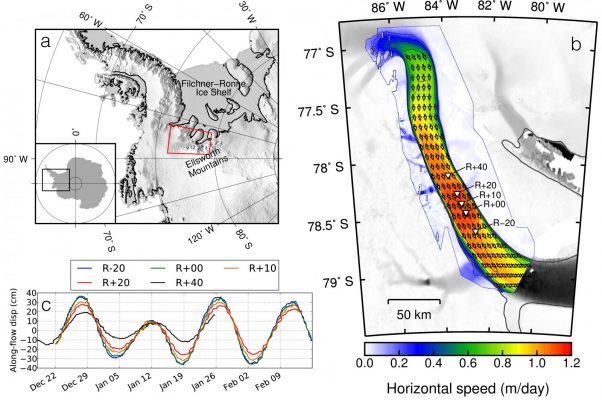Glaciers are mostly made of water. Sometimes, perhaps more than we’d like, some of that water makes a break for it by melting, the inconstant molecule… It might pootle around on the surface of the glacier a bit and get a lot of remote sensers very excited, but it’s what it does once it gets to the base of the glacier that really matters for the behaviour and flow of the ice. So, in 2000 word ...[Read More]
Climate Change & Cryosphere – Caucasus Glaciers Receding

The Tviberi Glacier valley is located in the Svaneti Region – a historic province of the Georgian Caucasus. Between 1884 and 2011, climate change has led to a dramatic retreat of the ice in this valley. Other glaciers in the Greater Caucasus evolved in a similar way in past decades. We investigated glaciers and their changes both in-situ and with remote sensing techniques in the 53 river bas ...[Read More]
Image of the Week – Karthaus Summer School 2018
Nearly every year since the late 90s, during the summer, the picturesque Karthaus has hosted 10-day glaciology course. This school is a platform for glaciologists to explore, learn and expand their knowledge base. This helps researchers become multi-faceted: to view glaciology from the perspective of those specializing in other backgrounds such as hydrology, geomorphology, oceanography, etc. which ...[Read More]
Image of the Week – Karthaus Summer School 2017
Glaciologists often undertake fieldwork in remote and difficult to access locations, which perhaps explains why they happily travel to similar locations to attend meetings and workshops. The Karthaus Summer School, which focuses on Ice Sheets and Glaciers in the Climate System, is no exception. The idyllic village of Karthaus, located in the narrow Schnalstal valley in Südtirol (Italy), has been h ...[Read More]
Image of the Week – A new way to compute ice dynamic changes
Up to now, ice sheet mass changes due to ice dynamics have been computed from satellite observations that suffer from sparse coverage in time and space. A new method allows us to compute these changes on much wider temporal and spatial scales. But how does this method work? Let us discover the different steps by having a look at Enderby Land in East Antarctica, for which ice velocities are shown i ...[Read More]
Image of the Week – How geometry limits thinning in the interior of the Greenland Ice Sheet

The Greenland ice sheet flows from the interior out to the margins, forming fast flowing, channelized rivers of ice that end in fjords along the coast. Glaciologists call these “outlet glaciers” and a large portion of the mass loss from the Greenland ice sheet is occurring because of changes to these glaciers. The end of the glacier that sits in the fjord is exposed to warm ocean water that can me ...[Read More]
Image of the Week – Supraglacial debris variations in space and time!

There is still a huge amount we don’t know about how glaciers respond to climate change. One of the most challenging areas is determining the response of debris-covered glaciers. Previously, we have reported on a number of fieldwork expeditions to debris-covered glaciers but with this Image of The Week we want to show you another way to investigate these complex glaciers – numerical modelling! Deb ...[Read More]
Image of the Week – How ocean tides affect ice flow

Ice streams discharge approximately 90% of the Antarctic ice onto ice shelves , and ultimately into the sea into the sea (Bamber et al., 2000; Rignot et al., 2011). Whilst flow-speed changes on annual timescales are frequently discussed, we consider here what happens on much shorter timescales! Previous studies have shown that ice streams can respond to ocean tides at distances up to 100km inland ...[Read More]
Image of the Week: Icequakes! Stick-Slip motion under Western Greenland

The Greenland Ice Sheet contains enough fresh water to raise global sea level by around 6 m, therefore it is very important to understand how the ice moves from the interior of the ice sheet towards the oceans. Processes that happen at the base of the ice sheet, where the ice meets the bed, are known to be a key control on how the ice moves. Geophysical techniques, such as recording tiny icequakes ...[Read More]
